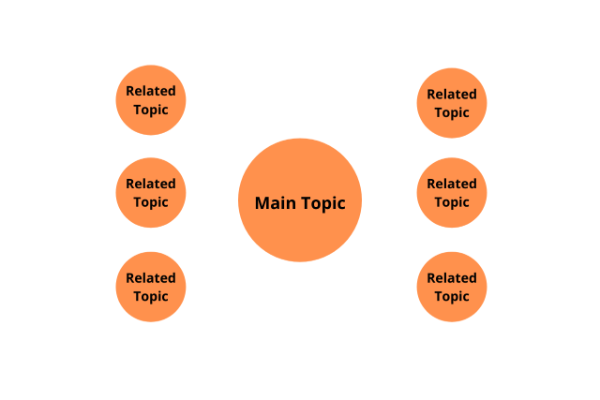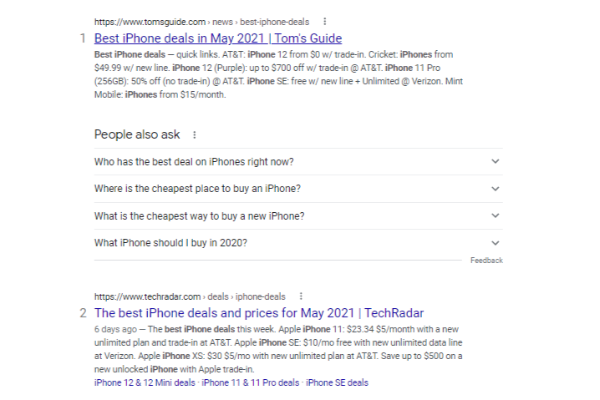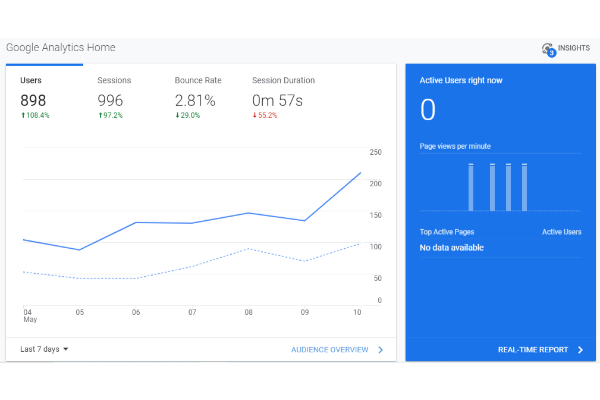
Semantic search isn’t only for organic traffic; it’s for paid search as well. Understanding the difference between broad and exact match search is important, but semantics is all about the search intent behind a query.
Google is focusing a lot more on search intent and keyword variants. Knowing the correlation between intent and semantics can help you narrow down to the perfect audience.
How Does Semantic Search Work?
What is semantics, and how does it apply to search? Semantics focuses on the search intent of a keyword and the thoughts and feelings that the person has as they search that keyword.
It’s a complicated subject, and there isn’t a “black and white” set of steps to follow. A lot of context and concept is behind every search query, and many SEOs overlook this by thinking basic keyword research will solve all their problems.
When it comes to semantics for paid campaigns, we’re talking about incorrect spelling, plurals, variants, synonyms, and other related words and phrases pertaining to the search word.
If we understand what semantics is, we can understand how it impacts paid search.
The goal of every advertiser on Google is to gain visibility for as many applicable keywords as possible. The problem is, no matter how much keyword research you put in on Ubersuggest, Ahrefs, and SEMrush, you’ll never find all the keywords that people in your target audience are searching.
This is where semantics come in.
Google uses semantics in broad and phrase search to help find a wider range of searches and triggers that will match user intent and display your ad.
Exact Match Vs. Broad Match in Semantic Search
To understand semantics, it’s important to know the difference between exact and broad match in Google ads. An exact match requires the searcher to input the exact keyword you’ve chosen to display your ad on.
For example, if you used the exact match “wedding cakes,” the person searching must enter some of the following keywords into Google to display your ad:
- wedding cakes
- white wedding cakes
- chocolate wedding cakes
- cheap wedding cakes
- and so on
These are exact match keywords because they contain the phrase exactly as-is. As a result, this type of advertising doesn’t use semantics because it doesn’t allow the flexibility necessary to locate related phrases with the same search intent.
Here’s another example: If someone searches for “cakes for weddings” or “weding cakes,” your ad may not display because Google thinks it doesn’t match your intention.
Even though the search intent is the same, you’re not using semantics in your advertising and may experience a higher CPC because you’re targeting a much narrower audience than necessary.
Using Semantics for Paid Vs. Organic Search
When it comes to organic search, many SEOs and site owners like to find every slight permutation of a keyword and include it somewhere in their content. At one time, this was the best strategy.
However, with the RankBrain update, Google started to implement machine learning and AI to understand the search intent and context of the search rather than rewarding the people stacking as many exact match keywords into their content as possible.
The goal is to make the process of finding information on Google as natural and conversational as possible.
For example, if you asked a friend, “Who is the richest person in the world?” they might respond, Jeff Bezos.
If you then asked, “Who has the most money in the world?” the answer would be the same, correct?
This factor should apply to Google search as well. Just because two people ask the same question differently doesn’t mean they should receive two different sets of search results. The question has the same intent, and the query demands the same answer.
If we apply this to organic search, it would tell us that we don’t need to worry so much about getting every single variation of the keyword because Google will identify the similarities and help us rank for all the keywords with the same intent.
On a different note, Google’s machine learning is using your habits as a searcher too. After searching for the richest person in the world on Google, I searched “most money” to see what that would bring.
The number-one result on Google was still relevant to my original search. Since I didn’t click through to anything, Google is still scrambling to find an answer to my query.
Why Should You Use Semantics for Paid Search?
Google released data that tells us how important semantics are for paid search. Approximately 15 percent of daily searches are new searches that they’ve never seen before. If those 15 percent of searches have never entered Google’s database before, how could anyone ever pick them up using keyword research or competitive analysis?
You can’t.
When it comes to long-tail keywords, the goal is to grab as many of those as possible. However, thousands and thousands of search phrases never hit the keyword research phase because they yield no traffic, and most people would never include a keyword with no traffic in their content.
Unless Google does it for you.
This factor has become ever prevalent with the rise of voice search as well. Voice commands are much more common today than they were when released in 2011. Twenty-seven percent of the population uses voice search on their phones. It’s also believed that 62 percent of individuals would make a purchase using voice technology on their smart home device.
We all know that people do not speak the way they search on Google. Semantics play a major role in Google’s ability to take a voice search and translate it into accurate results.
3 Steps to Use Semantic Search for Paid Ads
What can you do to capitalize on semantics? By now, we see the importance of semantics for paid search, but what should you do to ensure you’re reaching as much of your audience as possible?
- Worry Less About Keywords for Semantics
We should all worry less about creating content around keywords and instead create content around topics.
The goal is to cover a topic as in-depth as possible, and the keywords will come naturally.
A lot of SEOs talk about “silos” and “clusters.” These two strategies help you build out content in a way that increases site relevancy and boosts authority. By doing this, you’re showing Google that you’re an expert on the subject, and it should give you precedence over your competition.
- Focus More on Intent
I’m always preaching the importance of search intent, but this has become Google’s bread and butter. It makes it more difficult for SEOs to game the system by stacking a bunch of keywords in their content.
When choosing keywords for a paid search, you want to focus on the thought behind the keyword and target the intent. Think about the queries that lead people to your website.
What are they trying to do when they come to your site?
Are people there to learn something? Purchase something? Inquire about something? Once you’ve determined that, you’ll want to find keywords matching that intent.
In this image, the keyword “best deals on iPhones” has a different search intent than “best iPhones,” pictured below. While they both contain a similar phrase, the person searching is trying to accomplish different things.
Someone searching for deals is already in buy mode; they want to buy an iPhone and are looking for good deals.
Someone searching for the best iPhones may not have settled on the phone yet. They want to research brands, quality, read reviews, and learn more before making a purchase.
These two individuals are at different steps in the buying process.
Understanding this can help get more people to your site and may even decrease your bounce rate because they’ll get more of what they bargained for when they land. - Don’t Ignore User Experience When It Comes to Semantics
With the release of Core Web Vitals, we know that Google is paying attention to the on-site experience. Factors such as loading speed, load delay, and page layout are important.
Focus is shifting away from advertisers and affiliates and turning to the users. Google doesn’t care about how well you understand SEO and how many hours you spent on keyword research.
All they care about is that people get what they want on your site. If you’re giving people what they want, Google will reward you. If you’re not, they’ll reward your competition.
For many years, site owners pumped out sub-par keyword-loaded content built to rank but ignored the people searching for those keywords. That won’t cut it anymore.
Work on improving your page speed, optimizing your site for mobile, and pay attention to bounce rate and session duration. These are all indicators of whether or not you’re choosing the right keywords and targeting the right audience.
If you find that certain paid ad keywords have a higher bounce rate, it could mean you don’t have the right search intent. Semantic advertising isn’t all about verbiage; it’s also about relevancy. You could have the best offer in the world, but it won’t mean anything if your site doesn’t function properly.
Measuring the Success of Your Paid Search Campaign Using Semantics
How can you measure the success of semantic search in paid ads? The most important metric you’ll want to track is the success of individual broad-match keywords. By finding out which words Google’s AI is displaying your ad for, you can determine whether you should continue advertising for that broad-match keyword.
For example, if you’re advertising a site that sells iPhone cases, and you find that your audience’s search intent doesn’t align with the phrases your ad is displaying for, you might want to readjust or target something different altogether.
Two other metrics that can tell you a lot about the success of your campaign are the bounce rate and average time on page. If you’re targeting the right audience and bringing the right people onto your page, they’ll likely stay awhile.
If you have a 90 percent bounce rate and an average time on a page of less than a minute, chances are people are landing on your site, not liking what they see, and going somewhere else.
This could be a sign of a deeper on-site issue, but for this example, you might want to make sure you’re sending the right people through.

You can use tools like Google Analytics or the Google Ad dashboard to explore this data.
Conclusion
Much of this article will be great news for many of you. It means you don’t have to lose your mind on hours of keyword research anymore. By using broad matches and focusing on intent, you could pick up all the relevant keywords without having to identify them manually.
If you need a little more help, we can walk you through the steps necessary to get your campaign up and running.
The paid ad space is constantly changing and adapting to the digital environment, and we all have to jump aboard and roll with the changes. If we don’t, we risk letting our competition get ahead while paying more per click and receiving lower-quality click-throughs.
Be sure to keep semantics in mind as you set up your paid campaigns and really think about what the individual is trying to accomplish when they type a phrase into Google.
How have you used semantics to narrow down on your target audience?
from Blog – Neil Patel https://ift.tt/3vatONF
via IFTTT
No comments:
Post a Comment